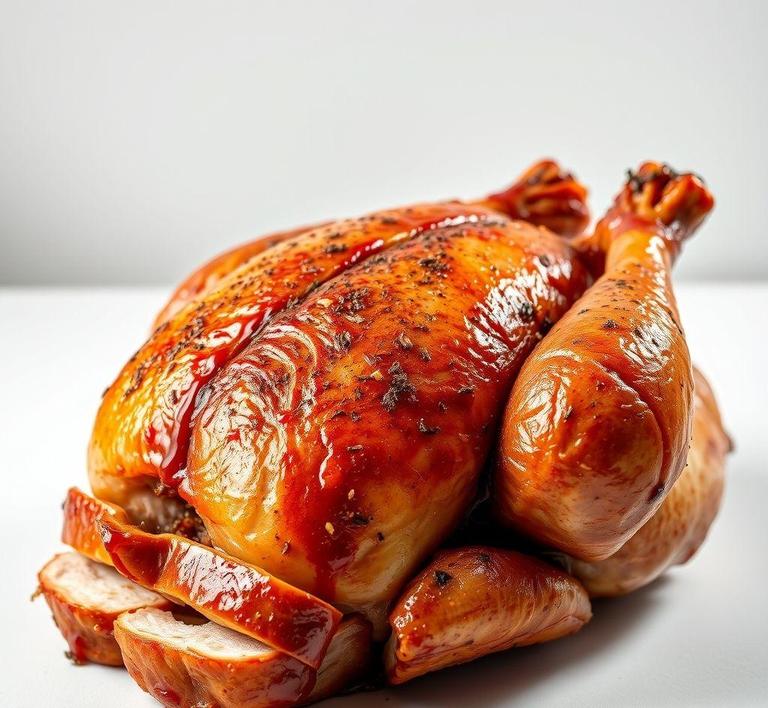If you’ve cooked a turkey crown and have leftovers, you might be wondering whether it’s safe or practical to refreeze it. Refreezing turkey crowns can be a great way to preserve those delicious leftovers for future meals, but there are some important guidelines to follow. From ensuring proper storage to understanding the effects on texture and flavor, knowing how to handle your turkey crown properly can help you make the most of your leftovers. In this guide, we’ll walk you through the do’s and don’ts of refreezing turkey crowns so you can keep your meals safe and tasty for weeks to come.
Can You Refreeze Turkey Crown?

Refreezing turkey crown, like other poultry, is a common query in households that aim to make the most of leftovers. Whether it’s due to a large feast or simply a desire to keep the bird for a later date, the question of refreezing arises. The short answer is: yes, you can refreeze a turkey crown, but with some important guidelines to ensure safety, taste, and texture preservation.
When you thaw a frozen turkey crown, it’s crucial to handle it properly to avoid any food safety risks, such as bacterial growth. If the turkey has been thawed in the refrigerator, it’s generally safe to refreeze it within 1-2 days. However, if the turkey has been thawed at room temperature or in warm water, it should not be refrozen due to the risk of bacterial contamination that can occur when the meat reaches temperatures above 40°F (4°C) for too long. This is why the method of thawing is key to determining if you can safely refreeze a turkey crown.
For a turkey crown that has been properly thawed and stored, it’s perfectly fine to refreeze. It’s also worth noting that the quality and texture of the turkey may degrade slightly with each freeze-thaw cycle, so it’s best to refreeze only once.
How To Refreeze Turkey Crown?
To ensure your turkey crown remains safe and maintains as much quality as possible when refrozen, it’s essential to follow the correct steps. Here’s a guide to doing so safely and effectively:
- Thaw Properly: First, make sure the turkey crown was thawed in the refrigerator or another safe, controlled environment. If thawed in a microwave or cold water, it should be cooked immediately and not refrozen.
- Cook the Turkey Crown: If your turkey has already been cooked after thawing, you can refreeze it with a much lower risk of bacteria buildup. Cooking the turkey makes it safer to refreeze, and it will help preserve the flavor and texture. Ensure the turkey is fully cooked, reaching an internal temperature of 165°F (74°C) to kill any harmful bacteria.
- Cool Quickly: After cooking, let the turkey cool down quickly to prevent the growth of bacteria. The USDA recommends that cooked poultry be left out for no more than two hours (or one hour if the room is above 90°F / 32°C). Once it’s cooled, place it in airtight containers or tightly wrapped in heavy-duty aluminum foil or plastic wrap.
- Wrap Properly: Use freezer bags or containers that are airtight. Wrapping your turkey crown tightly minimizes exposure to air and prevents freezer burn, which can ruin the texture and taste of the meat. Removing as much air as possible will help maintain the turkey’s quality.
- Label & Date: Always label your containers or bags with the date so you can keep track of how long it’s been stored in the freezer. Turkey crown, like any frozen meat, should be used within 3-4 months for optimal flavor and texture.
- Freeze Quickly: Place the wrapped turkey crown in the coldest part of your freezer to freeze it as quickly as possible. Rapid freezing helps preserve the integrity of the meat, reducing the formation of ice crystals, which can affect the texture.
Quality Impact
While it’s entirely safe to refreeze a turkey crown, there is one area where the process can cause some issues: quality. Each time you freeze and thaw poultry, there’s a potential for moisture loss, which can negatively affect both the texture and flavor of the meat. This happens because the freezing process forms ice crystals in the meat’s cellular structure, and as the turkey thaws, some of the moisture escapes.
Texture: Refreezing can make the turkey more dry and stringy, particularly in areas like the breast, where the meat is leaner. The texture might also become slightly rubbery, especially if the turkey has been cooked, frozen, and thawed multiple times.
Flavor: While the flavor of the turkey will not be severely impacted, it might lose some of its initial juiciness and savory richness. The longer the turkey is stored in the freezer, the more likely it is that the quality will decline, which can lead to a slight ‘freezer burn’ taste. This is especially the case if air has been allowed to infiltrate the packaging.
Nutritional Value: Refreezing does not affect the nutritional value of the turkey significantly, as long as the meat is stored properly. However, repeated freezing and thawing can make it less palatable and may degrade some vitamins and minerals due to the loss of moisture.
Overall Impact: The initial freeze-thaw cycle will have less of an impact on the turkey than repeated cycles. For the best quality, limit refreezing to only one cycle. This will help retain as much flavor and moisture as possible.
While you can refreeze a turkey crown, it’s important to do so safely and with the understanding that the texture and quality may suffer with each cycle. Refreezing is best done with a turkey crown that has been cooked and stored properly, ensuring you avoid any food safety issues. By following proper procedures-such as cooling the turkey quickly, wrapping it tightly, and labeling it for easy tracking-you can minimize the loss of quality.
For the best results, try to refreeze the turkey only once and within a short timeframe. Keep in mind that while the flavor may remain fairly consistent, the texture might degrade, leading to drier, less tender meat. So, if you’re in a situation where you need to refreeze, remember: it’s safe, but it’s not ideal if you’re hoping for the same juicy, tender texture of a freshly cooked turkey crown.
Is It Safe To Refreeze Turkey Crown?
Refreezing turkey crown can be a bit of a gray area when it comes to food safety. The primary concern with refreezing any meat-turkey crown included-is the risk of bacterial growth, which can happen when the meat is thawed and not handled properly. The general rule to follow is that if a turkey crown (or any poultry) has been thawed in the refrigerator, it can be safely refrozen, but there are important caveats to keep in mind.
When you thaw a turkey crown, the process should ideally happen in the fridge, where the temperature remains consistently low (below 40°F or 4°C). If the turkey was thawed at room temperature, or if it sat in a warm environment for too long, bacteria can start multiplying rapidly, and refreezing may only halt this growth temporarily, without fully eliminating the danger of foodborne illness.
When it comes to refreezing, it’s not about whether it’s "safe" to do so in the literal sense-it’s more about the quality of the meat and how it was handled throughout the process. Refreezing will often lead to a loss in texture, flavor, and moisture, but it doesn’t necessarily make the meat unsafe, provided that food safety guidelines were followed during the thawing and handling stages.
Signs That Turkey Crown Should Not Be Refrozen
Before refreezing a turkey crown, it’s essential to assess its condition thoroughly. There are several signs that indicate it should not be refrozen:
- Temperature Concerns: If the turkey crown has been left at room temperature for longer than two hours (or one hour if the temperature is above 90°F/32°C), it should not be refrozen. This is because bacteria can multiply quickly within the ‘danger zone’ of 40°F-140°F (4°C-60°C), making it unsafe to eat.
- Unpleasant Odor: One of the clearest indicators that a turkey crown has gone bad is a foul or sour smell. Even if it hasn’t been left out for long, any signs of off-putting odor mean the meat has begun to spoil, and refreezing will not salvage it.
- Discoloration: If the turkey crown has developed an unusual color-such as gray or greenish spots-it’s a sign that bacteria or mold might be present. Such meat should be discarded immediately.
- Excessive Slime or Stickiness: If you notice a slimy or sticky coating on the turkey crown, this is another sign that harmful bacteria have started to grow. This texture is a clear indication that the meat is no longer safe to consume, let alone refreeze.
- Extended Thawing Time: If the turkey has been thawed outside of the fridge for an extended period, or if it’s been sitting in a warm environment (like a hot car or kitchen counter), it has likely exceeded the safe thawing time. In such cases, it’s best to discard the meat rather than attempt to refreeze it.
Common Refreezing Mistakes
When handling frozen turkey crowns, there are a few common mistakes people often make, which can negatively impact the safety and quality of the meat:
- Not Thawing in the Refrigerator: One of the most common mistakes is not allowing the turkey crown to thaw in the fridge. Thawing at room temperature or in warm water promotes bacterial growth, which not only makes refreezing dangerous but also compromises the meat’s safety and flavor.
- Refreezing Multiple Times: Refreezing a turkey crown multiple times is a significant mistake. Each time you thaw and refreeze meat, the texture degrades, moisture is lost, and there’s a higher chance of harmful bacteria proliferating. It’s best to refreeze only once and cook it thoroughly once thawed.
- Inconsistent Freezer Temperature: A freezer should maintain a constant temperature of 0°F (-18°C) to ensure that the turkey crown stays safely frozen. If your freezer has fluctuating temperatures-such as from frequent door openings or inconsistent cooling-it can cause partial thawing, allowing bacteria to grow and ruining the texture of the meat when refrozen.
- Refreezing Without Proper Packaging: When you plan to refreeze a turkey crown, it’s crucial to package it properly to protect it from freezer burn. Using airtight packaging, such as heavy-duty freezer bags or vacuum-sealed bags, prevents air from entering and drying out the meat, which can significantly affect the flavor and texture.
- Not Cooking Before Refreezing: Some people mistakenly think that they can refreeze a cooked turkey crown, but doing so can often result in a mushy texture and diminished flavor when reheated. If you must refreeze a cooked turkey crown, make sure it’s done quickly and is sealed properly to prevent freezer burn.
Tips And Tricks
If you’re going to go ahead with refreezing your turkey crown, here are some tips and tricks to help you maintain the best possible outcome:
- Thaw Safely: Always thaw your turkey crown in the fridge. This ensures that the meat stays at a safe temperature throughout the process, preventing bacterial growth. Plan ahead, as thawing in the fridge can take several days depending on the size of the turkey.
- Use a Meat Thermometer: Before deciding to refreeze or cook a turkey crown, always check its internal temperature. If it’s been sitting out for a while, the temperature should not exceed 40°F (4°C) to ensure it’s still safe to handle.
- Portion It Out: If you don’t plan on using the entire turkey crown in one go, consider cutting it into smaller portions before freezing. This makes it easier to defrost only what you need, reducing the need to refreeze.
- Wrap it Well: Use heavy-duty plastic wrap, foil, or a vacuum sealer to wrap your turkey crown. This prevents air from reaching the meat and causing freezer burn, which would degrade the quality and flavor of the turkey.
- Cook Before Refreezing: If you’re in doubt, it’s often best to cook the turkey crown first before freezing. Cooking will kill any bacteria that might be present, and when you refreeze the cooked meat, it will maintain a higher quality.
- Label the Freezer Bag: When you refreeze your turkey crown, make sure to label it with the date it was frozen. Meat that has been frozen for an extended period can start to lose quality, so it’s a good idea to use it within a few months.
- Don’t Refreeze Leftovers: Once you’ve cooked the turkey crown and have leftovers, only refreeze it if it has been handled properly during the cooling process. Leftover turkey should be refrigerated within two hours of cooking, and it should not be kept at room temperature for an extended period before being refrozen.
Conclusion
Refreezing turkey crown can be done safely, but it requires careful handling and a clear understanding of food safety practices. Thawing properly in the refrigerator, avoiding extended time at room temperature, and paying attention to any signs of spoilage are crucial to maintaining both the safety and the quality of the turkey. By following these guidelines, you can refreeze your turkey crown without worrying about potential health risks or a ruined texture.
Ultimately, while refreezing is possible, the key is to handle the meat with care throughout the entire process-from thawing to packaging and refreezing. Keep in mind that while the turkey crown might not be as flavorful or tender once refrozen, it can still be a safe and viable option for later use when done correctly.


